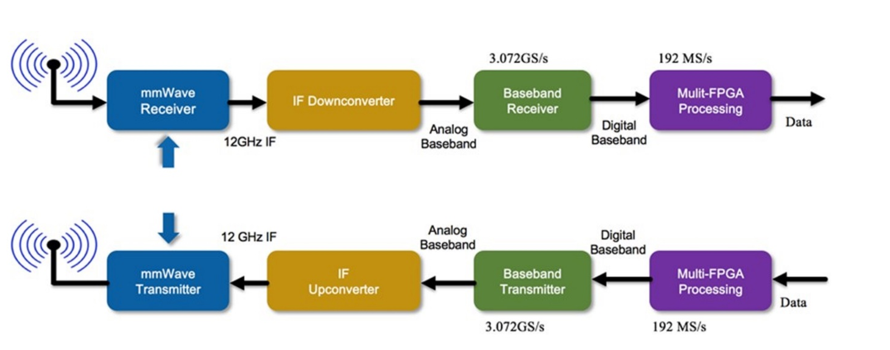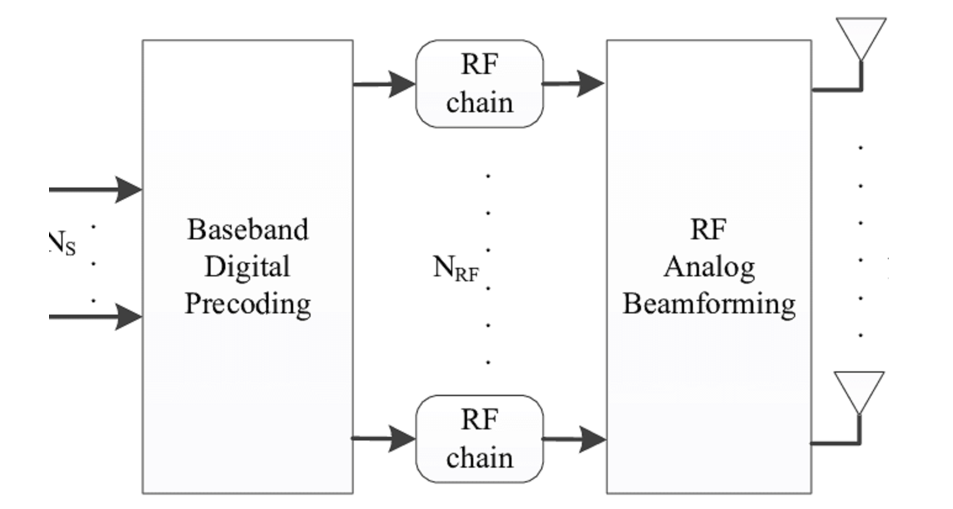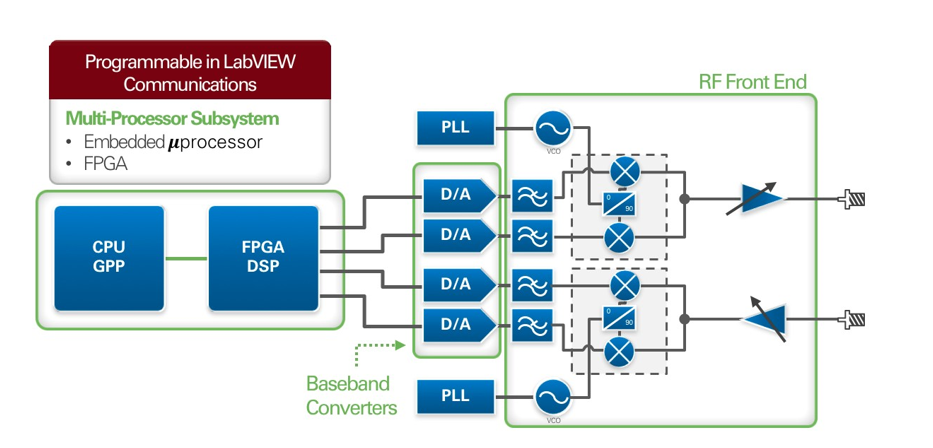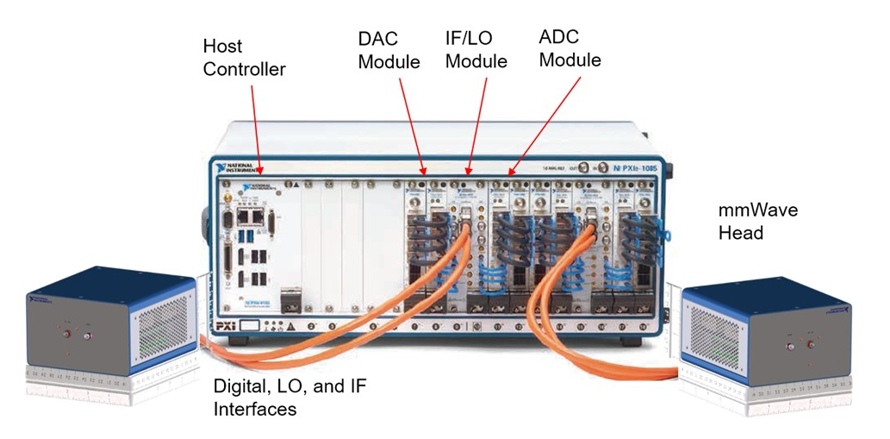The Case for Hybrid Beamforming in 5G mmWave Prototypes
Beam management, a defining feature in mmWave communications, entails highly directional and steerable beams in single- and multi-user scenarios. It will play a crucial role in the future of 5G wireless designs, because the 3GPP Release 15 specification outlines the basics of beam management. Likewise, the 3GPP Release 16 examines the real-world performance of phased array antennas in the context of beam management.
The mmWave systems with a large antenna count enable narrow beam patterns, and that makes antenna performance and beam characteristics important considerations in choosing the algorithms for beam management. This article will examine the real-world performance of phased array antennas in the context of beam management. It will also provide a design example of hardware prototyping for 5G system beamforming and beamsteering.

Figure 1: The fundamental building blocks of the mmWave communication system that often employs multiple beams to bolster the radio capacity. Source: National Instruments
Starting with the beamforming basics: The traditional analog beamforming creates a single beam by applying a phase delay, or time delay, to each antenna element. Here, for multiple simultaneous beams, designers need to use a phase delay for each incoming signal and then add the beam.
On the other hand, in full digital beamforming, each antenna mandates a dedicated analog baseband channel, which, in turn, calls for a digital transceiver for each antenna. This adds to both cost and power consumption. Enter hybrid beamforming, which allows designers to keep the overall cost and power consumption lower.
Why Hybrid BeamformingHybrid beamforming combines analog beamforming with digital precoding to intelligently form the patterns transmitted from a large antenna array (Figure 2), and the same technique is used at the receive end to create desired receiver pattern.

Figure 2: A view of hybrid beamforming structure for the mmWave transmitter. Source: Research Gate
Hybrid transceivers use a combination of analog beamformers in the RF and digital beamformers in the baseband domains, respectively, and that leads to fewer RF chains compared to the number of transmit elements. In other words, an architecture that is properly partitioned between the analog and digital domains.
The fact that hybrid beamforming uses a smaller number of RF chains, which otherwise have large power consumption, allows designers to use a larger number of antenna array elements while reducing energy consumption and system design complexity.
However, hybrid beamforming must include the precoding weights and RF phase shifts to meet the goal of improving the virtual connection between the base station and the user equipment (UE). Moreover, the precoder design mandates massive calculations such as the singular value decomposition (SVD) of the channel.
Here, a low complexity hybrid precoding algorithm employed for beamsteering operations utilizes array response vectors of the channel. The algorithm applies a set of array response vectors that are used to form the channel, so there is no need for complicated operations used in the traditional precoding algorithms.
The beamsteering algorithms are also critical in the capacity-based optimal beam set selection and in detecting the presence of unknown interference and noise. Additionally, they facilitate higher throughput by overcoming problems such as random beam blockage and misalignment.
mmWave Beamsteering AlgorithmsIn high-speed mmWave communications with large antenna arrays, frequent channel estimation is required because channel conditions vary rapidly. A vital part of channel estimation relates to an efficient beam searching in order to allow more time for data transmission.
Then, there is multi-beam selection, a crucial element in hybrid beamforming systems for frequency-selective fading channels. The impact of interference on network capacity due to highly narrow beams also poses serious challenges. It is therefore imperative that designers carefully examine the network capacity from both node capacity and antenna size standpoints.
Here, unlike the trial-and-error approach, which is time-consuming and does not easily adapt to change, beamsteering algorithms help engineers understand design constraints and account for them in the optimization process. They facilitate an arithmetic mean of signal yields, which, in turn, refines observations with minor noise effects and provide more accurate sparse multipath delay information.
These observations, for instance, regarding estimated multipath delay indices, are crucial in the selection of the analog beams. The beamsteering algorithms also play a vital role in phase control and beam tuning. They analyze the computational complexity and compare numerical results to deliver the best signal propagation and reception for mmWave communication channels.

Figure 3: A typical hardware architecture for running beamsteering algorithms comprises of CPU and FPGA modules programmable in software platforms like LabVIEW. Source: National Instruments
Take the Hybrid Beamforming Testbed from National Instruments (NI), which moves signals from the analog to the digital domain using an mmWave Transceiver System (Figure 3). This off-the-shelf prototyping system allows engineers to validate radio performance by efficiently implementing the mmWave beamsteering algorithms.
Hybrid Beamforming TestbedThe 5G NR standard for mmWave frequencies uses a combination of computationally intensive algorithms to encode, decode, modulate, demodulate and multiplex signals. Here, NI's mmWave Transceiver System, a software-defined radio (SDR) solution, can help implement beamforming algorithms for a variety of 5G prototyping use cases.
This modular prototyping system comprises a PXI Express chassis, controllers, a clock distribution module, high-performance FPGA modules, high-speed DACs and ADCs, LO and IF modules, and mmWave radio heads (Figure 4). The FPGA modules in the PXI chassis handle communication rules, error correction, decoding and encoding, and signal mapping.

Figure 4: The mmWave Transceiver System can be used as a hybrid beamforming testbed to design and test beamsteering algorithms. Source: National Instruments
Next, the baseband transceiver modules - along with the IF/LO modules - transmit and receive signals to and from the mmWave heads, which can be connected to the phased arrays via a single SMK cable. Here, the LabVIEW software allows developers to configure different connectivity features in the digital domain of beamforming.
So, network designers can combine the transceiver system with a phased array to create off-the-shelf phased array prototype solutions. And they can map different computational tasks on multiple FPGAs and thus design and test beam algorithms for a wide variety of mmWave channels and network configurations.
For more on this, go to National Instruments' website.